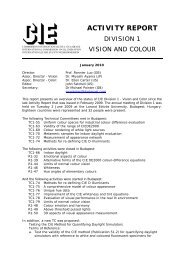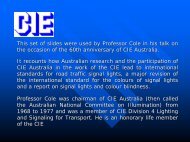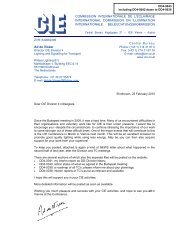commission internationale de l'eclairage international ... - CIE Australia
commission internationale de l'eclairage international ... - CIE Australia
commission internationale de l'eclairage international ... - CIE Australia
You also want an ePaper? Increase the reach of your titles
YUMPU automatically turns print PDFs into web optimized ePapers that Google loves.
COMMISSION INTERNATIONALE DE L'ECLAIRAGE<br />
INTERNATIONAL COMMISSION ON ILLUMINATION<br />
INTERNATIONALE BELEUCHTUNGSKOMMISSION<br />
<strong>CIE</strong> Central Bureau Kegelgasse 27 A-1030 Wien Austria<br />
C O M M I S S I O N INTERNA TIO N ALE D E L’ECLAIRAGE-<strong>CIE</strong><br />
- <strong>CIE</strong> Technical Committee TC 5-23<br />
R E P O R T O F T H E <strong>CIE</strong> TC 5-23 MEE T I N G O F 2 S E P T E M B E R 2008 I N HELSINKI - FINLAND<br />
Present<br />
Patrick Rombauts Presi<strong>de</strong>nt TC (BE) Jacques Lecocq France<br />
Kohji Kawakami Japan Tom Lemons USA<br />
Petr Zak Czech Republic Marko Bizjak (Guest) (Slovenia) ?<br />
Excused<br />
John Rogers <strong>Australia</strong><br />
Murray Cronje South-Africa<br />
José Luiz Pimenta Brasil<br />
1. Welcome<br />
This is the third meeting of this Technical Committee TC 5-23. Every present member or guest<br />
has been cordially welcomed and invited for active participation in the committee work. The<br />
atten<strong>de</strong>e’s list is attached.<br />
2. Terms of Reference of this TC<br />
The presi<strong>de</strong>nt would like to remind the participants of the modified terms of reference of this<br />
Technical Committee : “To write gui<strong>de</strong>lines for values of horizontal; vertical; semicylindrical;<br />
hemispherical and spherical cap illuminances as well as of cubic<br />
illumination for practical outdoor applications”. The new title of the TC is “Gui<strong>de</strong>lines<br />
for the use of different Illuminance parameters in Outdoor Applications”.<br />
3. Approval of the Report of the Meeting in Beijing – China (10 July 2007)<br />
The report of the meeting was approved without further remarks.<br />
<strong>CIE</strong> TC 5-23 Meeting Report 2_9_2008 Helsinki - Finland 1/6
4. Discussion of the Draft Report version 3<br />
This document is an intermediate document in view of a new core document that covers better<br />
the new terms of reference.<br />
Jacques Lecocq will send a English text “Illuminances on 3D point surfaces and visual<br />
perception” to be incorporated in the <strong>CIE</strong> document §4.7.<br />
J. Lecocq is working on the mo<strong>de</strong>l of visibility of Werner Adrian for road lighting. He also<br />
wants to state that semi-cylindrical and cylindrical illuminances are no good characterising<br />
parameters here. In the future we will take more and more pictures and so we ought to speak<br />
of luminances; and from there we are able to simulate the spreading of luminances, which was<br />
not possible up to now ! We should apply this in all lighting issues and even for the oncoming<br />
driver in road lighting. Eventually, there could be a liaison set up with <strong>CIE</strong> TC 4-36 and take<br />
also into account glare, the road surface and the oncoming driver with his/her headlights.<br />
We never take into account specular surfaces in the calculation for a ping-pong ball f.i. as it is<br />
consi<strong>de</strong>red matt. Measurements on the contrary are eventually carried out with specular<br />
surfaces. This represents a secondary issue.<br />
The objects are sometimes flat, but they are moving; observers are moving too as with<br />
swimming.<br />
Vertical illuminance is neither a good parameter, it has no capacity with illumination.<br />
Eventually simplifying the issue by consi<strong>de</strong>ring flat objects is associated with too much lighting<br />
in the proximity of the light source.<br />
Glare is also more important in certain directions. With visibility, luminance is the concept to<br />
apply, together with colour because of high illuminance levels. E. g. with flat objects, at 1200<br />
lux, there is need to overrating the lighting installation; one should preferably take then<br />
curved objects and the concept of illuminance on spherical cap.<br />
J. Lecocq wants to mention that the global uniformity is around 0,6 and that the luminance<br />
gradient on the object has not yet been studied; anyway the luminance contrast is a useful<br />
concept. The background is consi<strong>de</strong>red more or less uniform and if the object luminance is<br />
equal to the background luminance then the object is invisible as in road lighting.<br />
J. Lecocq is seriously questioning the concept of hemispherical illuminance for the <strong>de</strong>tection of<br />
objects on the ground and one should merely use two-dimensional illuminance normal to the<br />
camera - or according to another well-<strong>de</strong>fined direction - as the concept (and not purely<br />
“vertical” illuminance).<br />
J. Lecocq has created a “real lux meter” that is able to measure hemispherical and spherical<br />
cap illuminances <strong>de</strong>pending on the viewing direction (notwithstanding Axel Stockmar's thesis –<br />
see the paragraph at the end of this report); as measurements are nee<strong>de</strong>d in any case to<br />
verify and to validate the calculations and to numerically <strong>de</strong>fine the concept of spherical cap<br />
illuminance. Petr Zák replies that cubic illumination is concerning 6 surfaces and there is<br />
in<strong>de</strong>ed lack of a concept that is able to calculate the back of an object and J. Lecocq is adding<br />
that we should treat light as a “vector” with varying directions. Petr Zák would like to stress<br />
the fact that illuminance concepts are not direction related of which J. Lecocq states that even<br />
horizontal or vertical illuminances are direction related anyway. Both agree with the<br />
luminance concept as calculation mo<strong>de</strong> which is explicitly direction related.<br />
Petr Zák wishes to conclu<strong>de</strong> provisionally in a sense that the way (i.e. the geometrical<br />
distribution and the intensity) light is falling on an object is very important too; and that the<br />
shape of an object is not <strong>de</strong>termined by the illuminance distribution but by the luminance<br />
distribution and colour. We are able to take photographs with a luminance and colour sensitive<br />
film but we can not calculate the proper visibility yet today.<br />
Kohji Kawakami will send by spring 2009 another text “Recommendation for Sports Lighting<br />
_JIS Draft 1” evenly to be implemented in the document on the subject of recognition of faces<br />
and objects in sports lighting.<br />
<strong>CIE</strong> TC 5-23 Meeting Report 2_9_2008 Helsinki - Finland 2/6
Tom Lemons wants to put forward that there exists a difference between the recognition of<br />
faces and that of a tennis ball or baseball as an example; it is in fact more than pure threedimensional<br />
appearance : is the ball spinning or not; where is the ball, as the ball can be<br />
everywhere ? Also, the backlight is very important.<br />
Tom Lemons wants to see a range of illuminances (values) for the user presented in this<br />
document.<br />
Tom Lemons would like to bring forward <strong>de</strong>scribing/<strong>de</strong>fining the illuminance concepts that are<br />
used in Denmark and Japan and simplify this as no real gui<strong>de</strong>lines are expected. He shall<br />
study the <strong>CIE</strong> Vocabulary and copy the <strong>de</strong>finitions. The DIN-norm is a reference too.<br />
P. Rombauts replies that we shall rely upon existing research and take these references where<br />
the calculations have been done or can be done.<br />
He wants to add cubic illumination apart from the already <strong>de</strong>fined concepts of semi-cylindrical,<br />
cylindrical, hemispherical and spherical cap illuminances. The extra content of “cubic<br />
illumination” could be borrowed from Kit Cuttle.<br />
Tom Lemons will prepare a text on “cubic illumination” and send the proposal to Kit Cuttle for<br />
approval.<br />
Petr Zák would like to mention that no further research has been carried out during the last<br />
year and he wants to propose an explicit linking of the illuminance values with matching,<br />
corresponding lighting applications. Tom Lemons replies that no new research is nee<strong>de</strong>d and<br />
that we should stick to the existing research and link it with the applications, including fill and<br />
backlight and TV.<br />
The scope and the terms of reference are expan<strong>de</strong>d to the “general characterisation of the<br />
lighting field”.<br />
Members and guests are asked by the chairman for input, i.e. theoretical and experimental<br />
work where can be referred to or that has been carried out for all types of illuminances, in<br />
particular cubic illumination.<br />
Major input came from Petr Zák (Czech Republic) with a paper (in Czech) on calculations and<br />
measurements of cubic illumination and the light vector; further cooperation is planned<br />
between Petr Zák and P. Rombauts (VUB) for research and master thesis work. Cubic<br />
illumination has been calculated and measured in a general field, compared to all other types<br />
of illuminances, like the E4p (spherical illuminance in a control point). Petr Zák’s research has<br />
finished at this point for now.<br />
Measurements are carried out via a 6 si<strong>de</strong>d standard illuminance meter (cubic illumination and<br />
spherical illuminance); a 5 si<strong>de</strong>d standard illuminance meter (hemispherical illuminance); a 4<br />
si<strong>de</strong>d standard illuminance meter (semi-cylindrical illuminance). Petr Zák states that with<br />
outdoor lighting applications, the field can be restricted and the relation will be simplier.<br />
Petr Zák has done some measurements to compare spherical with semi-cylindrical<br />
illuminances and he will look for this application to send the corresponding <strong>de</strong>tails to the TC<br />
chairman. Stu<strong>de</strong>nts of the Czech Praha University could carry out this work together with and<br />
un<strong>de</strong>r the responsability of Petr Zák.<br />
P. Rombauts asked himself if measurement comparison campaigns have been carried out<br />
between vertical, horizontal, semi-cylindrical, hemispherical and spherical cap illuminances<br />
and cubic illumination. Jacques Lecocq (FR) must have done so for sports lighting ?<br />
P. Rombauts refers to the work of Kohji Kawakami (JP) where a correlation between the<br />
face’s luminance and the face’s (vertical and semi-cylindrical) illuminance is showed.<br />
A Work Scheme will be established by P. Rombauts to meet the new terms of reference and to<br />
solve the issue of people face’s brightness, characterised by illuminance parameters, by<br />
setting up a stu<strong>de</strong>nt’s Master thesis project. The project will cover both calculations and<br />
experiments. Kohji Kawakami’s work will be of great help here.<br />
P. Rombauts is asking himself what types of outdoor lighting applications should be covered<br />
(sports, urban, pe<strong>de</strong>strian, …) ? And, with all the types of illuminances ?<br />
<strong>CIE</strong> TC 5-23 Meeting Report 2_9_2008 Helsinki - Finland 3/6
Further important input came from Kohji Kawakami (JP) : A Japanese Industry Standard<br />
on sports lighting is planned for publication in 2008 (the targets are e.g. the game balls and<br />
the human faces) <strong>de</strong>scribed by the space illumination characteristics ECyl and ESC (work on the<br />
Standard has been started 7 years ago).<br />
Axel Stockmar of Germany has published in the early 1980’s some papers on threedimensional<br />
illuminances, the lighting field and cubic illumination where the accuracy of the<br />
concepts and of the measurements is seriously put into question (see the lighting journals<br />
“Lichtforschung” and “Lichttechnik”). These papers have to be studied thoroughly again<br />
for implementation in the TC 5-23 document. In here, Axel Stockmar has proven that<br />
approximating cubic illumination by means of 4 vertical illuminance values (from the<br />
approximation formula of cubic illumination) is introducing very important errors (during that<br />
period huge computer capabilities were not yet available). Counting the negative term in the<br />
formula or not was not influencing the result; even when increasing the number of planes to<br />
11 for instance.<br />
Axel Stockmar has stated after this TC meeting that cubic illumination can better be directly<br />
calculated without any problem, and not be estimated by very inaccurate measurements.<br />
Axel Stockmar is questioning the validity of application of cubic illumination in outdoor<br />
environments because of its nature as “general field”. Petr Zák replies on this by stating that<br />
the outdoor lighting applications are no general field issues but on the contrary restricted<br />
fields, with formulae even simplier. Petr Zák wishes to express his agreement on the<br />
statement of poor accuracy of the cubic illumination measurements.<br />
5. Next meeting<br />
The next meeting will be held in Budapest_Hungary on the occasion of the Midterm Meeting<br />
of the <strong>CIE</strong> Divisions 4 & 5 between 1 and 3 June 2009.<br />
6. Activities to be carried out<br />
� C. Cuttle could be invited for the next meeting.<br />
� Tom Lemons will send a photocopy of the chapter of the book “Cubic Illumination” by<br />
C. Cuttle to P. Rombauts. Tom Lemons will also prepare a text on “Cubic Illumination”<br />
and send the proposal to Kit Cuttle for approval.<br />
� Petr Zák (Czech Republic) will translate his paper of 1999 on the integral<br />
characterisation of the lighting field from Czech to English.<br />
� The papers that Axel Stockmar of Germany has published in the early 1980’s in<br />
“Lichtforschung” and “Lichttechnik” on three-dimensional illuminances, the lighting<br />
field and cubic illumination have to be studied thoroughly again for implementation in<br />
the TC 5-23 document.<br />
� A Work Scheme will be established by P. Rombauts to meet the new terms of reference<br />
and to solve the issue of people face’s brightness, characterised by illuminance<br />
parameters, by setting up a stu<strong>de</strong>nt’s Master thesis project.<br />
� Eduardo Manzano (ES; AR) will be contacted for eventual input.<br />
<strong>CIE</strong> TC 5-23 Meeting Report 2_9_2008 Helsinki - Finland 4/6
<strong>CIE</strong> TC 5-23 Short Minutes Report on behalf of the <strong>CIE</strong> Division 5 Meeting September<br />
3rd 2008, Helsinki<br />
This TC held a meeting in Helsinki on September 2 nd 2008.<br />
Six people, among five members, atten<strong>de</strong>d the meeting and took part in the discussion.<br />
Interesting and substantial contributions came from Jacques Lecocq (FR), Tom Lemons (USA),<br />
Petr Zák (Czech Republic) and Kohji Kawakami (Japan).<br />
Because of the modified terms of reference, the third draft will be completely rewritten on<br />
basis of these contributions and research that has been and will be carried out in Prague (Petr<br />
Zák) and Brussels (Patrick Rombauts, VUB).<br />
The next meeting will be held in Budapest, Hungary between early June 2009.<br />
<strong>CIE</strong> TC 5-23 Meeting Report 2_9_2008 Helsinki - Finland 5/6
<strong>CIE</strong> TC 5-23 Meeting Report 2_9_2008 Helsinki - Finland 6/6







